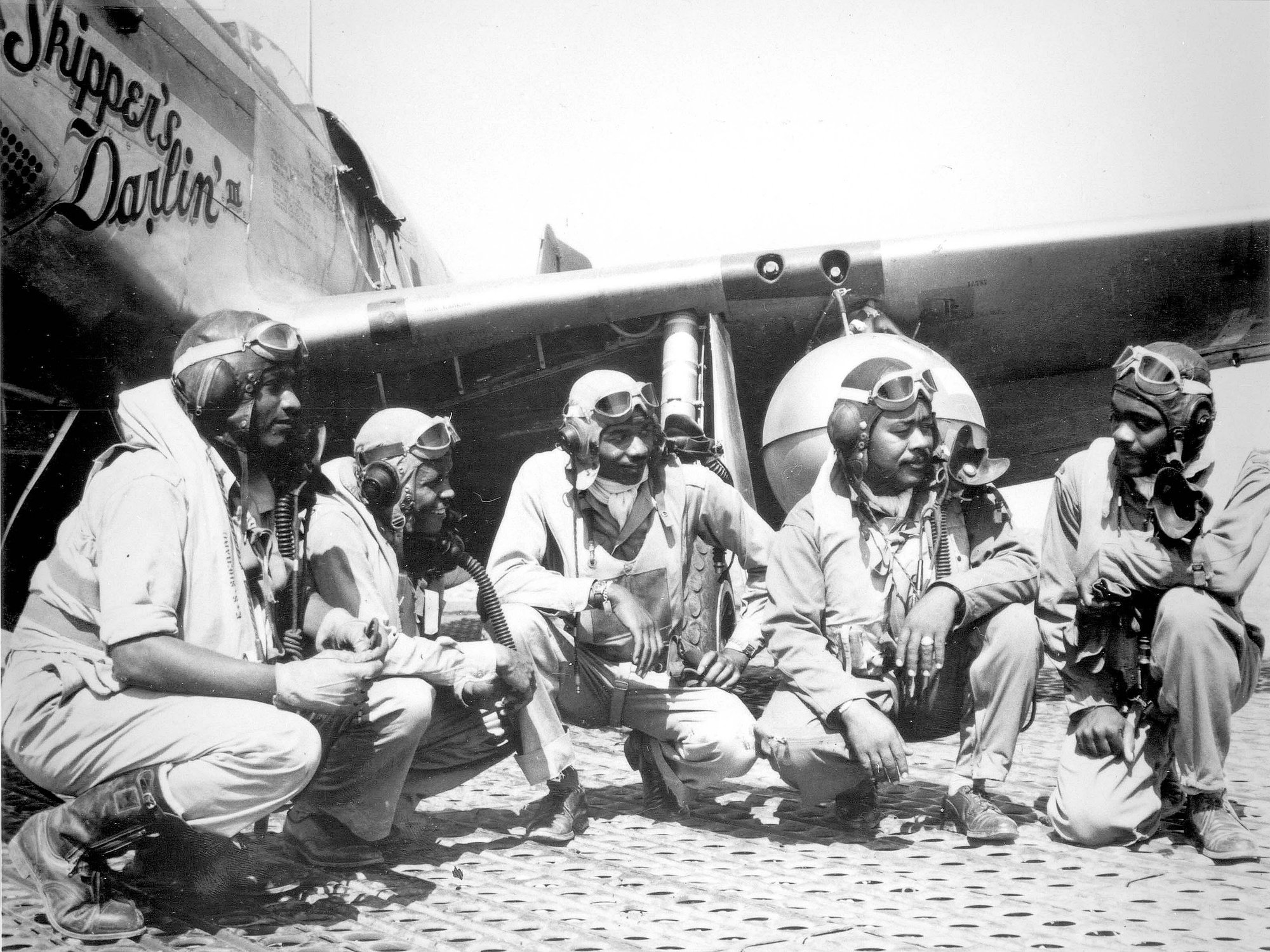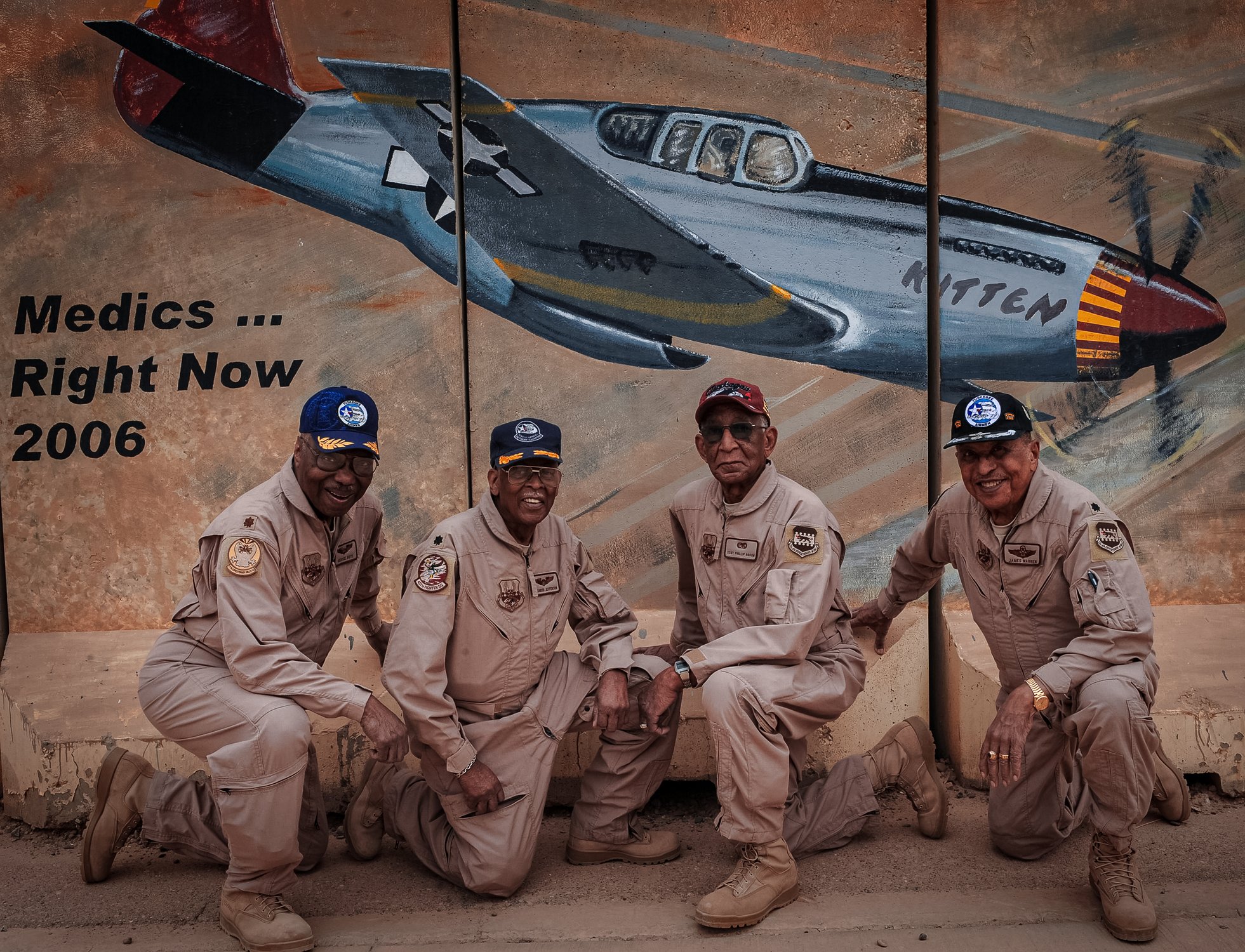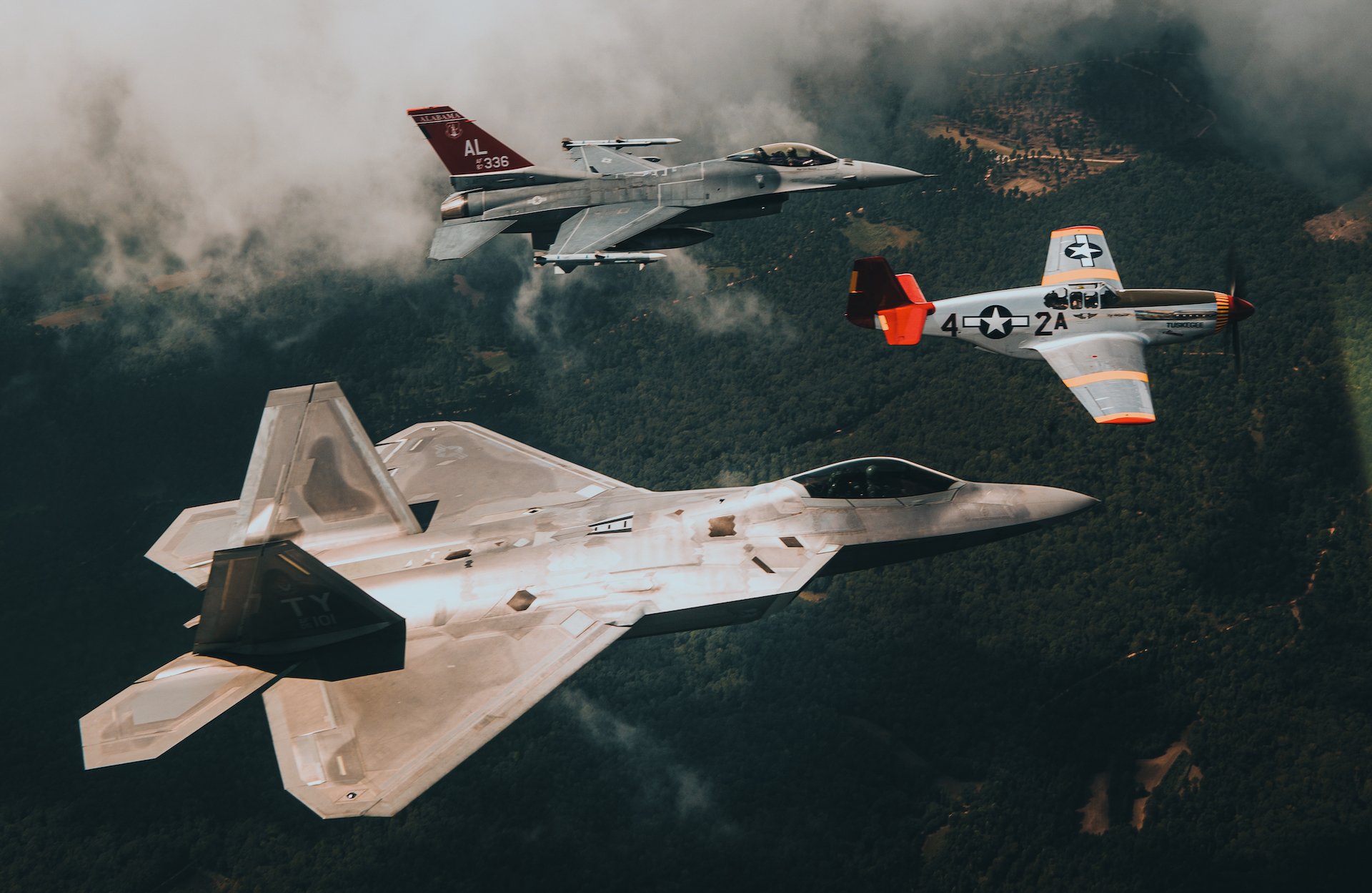
Pilots of the 332nd Fighter Group, the famed Tuskegee Airmen, at Ramitelli Airfield, Italy; from left to right, Lt. Dempsey W. Morgan, Lt. Carroll S. Woods, Lt. Robert H. Nelron Jr., Captain Andrew D. Turner, and Lt. Clarence P. Lester. Photo courtesy of the US Air Force/Wikimedia Commons.
The Tuskegee Airmen were an historic, all-Black combat aviation unit that flew more than 15,000 sorties over North Africa and Europe during World War II. Despite the institutionalized racism that plagued their military service, the legendary fighter pilots — known as the “Red Tails” — earned the respect and trust of the bomber crews they routinely escorted across enemy skies.
The story of the Red Tails is an important chapter in American history. It is a story of courage, perseverance, and triumph in the face of extreme adversity. Here are some of the highlights.
Related: Cargo Jet, Hurricane Hunter, Gunship: Evolution of the C-130
Eleanor Roosevelt Was an Early Supporter

First Lady Eleanor Roosevelt was a vocal advocate for integrating Black servicemembers into technically challenging positions within the Army Air Corps. US Air Force photo.
On January 16, 1941, the War Department announced the formation of the 99th Pursuit Squadron, a segregated unit that would be composed of the first Black airmen to ever serve in the U.S. Army Air Corps. The 429 enlisted men and 47 officers selected for its ranks began their journey with training at the Tuskegee Institute in Tuskegee, Alabama.
One day, First Lady Eleanor Roosevelt, a vocal advocate for integrating Black servicemembers into technically challenging positions within the Army Air Corps, arrived in Tuskegee to observe the 99th in training. To culminate her visit, Charles Alfred Anderson, a Black aviation pioneer and civilian flight instructor, took the first lady for a ride in his plane.
“The first thing she said was, ‘I always heard colored people couldn’t fly airplanes, but I see you’re flying all around here,’” Anderson later recalled in an interview with the Philadelphia Inquirer. According to Anderson, after the flight, Roosevelt remarked, “Well, I can see you can fly all right!”
The 99th Pursuit Squadron was officially activated on March 23, 1941. Several months later, President Franklin D. Roosevelt issued Executive Order 8802, which declared that there “shall be no discrimination in the employment of workers in defense industries and in Government, because of race, creed, color, or national origin.”
Related: Eddie Rickenbacker: America’s Most Decorated World War I Ace
Why Red Tails?

The 332nd’s aircraft had distinctive markings that gave them the name “Red Tails.” US Air Force photo.
The Tuskegee Airmen’s first aerial victory transpired in July 1943. Lt. Charles B. Hall, piloting his Curtiss-Wright P-40 Warhawk, shot down a German fighter while escorting B-25 medium bombers on a raid over Sicily.
In 1944, the 99th was merged into the 322nd Fighter Group, an all-Black wing of the 15th Air Force that consisted of three other squadrons out of Tuskegee: the 100th, 301st, and 302nd. The 322nd flew a total of 312 missions in Europe. More than half of those were bomber escort missions. To distinguish themselves from other squadrons, the Tuskagee Airmen painted the tails of their P-51C Mustangs a bright shade of red. As their reputation grew, the red tails became a welcomed sight for bomber crews flying through hostile airspace. Hence why they became known as the “Red Tails.”
Over the course of its tour, the Red Tails achieved 112 aerial victories. Approximately 84 Tuskegee Airmen lost their lives in the war.
Related: Wally Funk: The Aviation Pioneer Who Became The Oldest Person To Go To Space
The Myth of Their Spotless Record

Tuskegee Airmen (from left), retired Maj. George Boyd, retired Lt. Col. Alexander Jefferson, former Staff Sgt. Phillip Broome, and retired Lt. Col. James Warren, in front of barrier art depicting a “Red Tail” P-51 Mustang. US Air Force photo by Senior Airman Elizabeth Rissmiller.
Gen. Benjamin O. Davis Jr., the commanding officer of the 322nd, once claimed that zero bombers were lost while under escort by his fighter pilots. Although his claim has been repeated as fact in museums, books, magazine articles, and newspapers, it’s not true.
A 2011 analysis of the 322nd’s combat record revealed that at least 27 bombers were shot down by enemy aircraft while being escorted by Tuskagee Airmen. According to Air Force records, all 27 were lost during just seven missions, each of which involved hundreds of bombers.
Still, though the Red Tail’s record wasn’t spotless, it was exceptional relative to the exorbitant casualty rates suffered by the Army Air Corps in Europe. Among the other fighter squadrons of the 15th Air Force, the average number of lost bombers was 46.
Related: Legendary Fighter Pilot Robin Olds Was An Ace in Two Wars
After the War

A US Air Force F-22 Raptor, F-16 Fighting Falcon, and commemorative P-51 Mustang fly in formation over areas of Alabama on Sep. 6, 2018. US Air Force photo by Staff Sgt. Clayton Cupit.
Immediately after the war, the racial barriers that had confined Black servicemembers to segregated units began to fall. In 1948, President Harry S. Truman signed Executive Order 9981, mandating that “there shall be equality of treatment and opportunity for all persons in the armed forces without regard to race, color, religion, or national origin.”
Meanwhile, the Tuskegee Airmen proved to be more than just exceptional aviators. Many, including Gen. Davis Jr., went on to have long and successful military careers. Another notable alumni was Daniel “Chappie” James Jr., who in 1975 made history by becoming the first Black man to ever attain the rank of four-star general in the U.S. military.
James didn’t see action during World War II, as he spent the war training new Tuskegee pilots as a flight instructor, but he later flew 101 combat missions in Korea and another 78 in Vietnam. Perhaps the most famous episode of his career occurred while he was serving as the commander of the 7272nd Fighter Training Wing in Libya. In 1970, following Muammar Gaddafi’s successful overthrow of the Libyan government, the future dictator and his troops stormed the air base where the 7272nd was stationed. As the story goes, at one point, Gaddafi and James faced off, and Gaddafi reached for James’ gun.
“I had my .45 in my belt,” James would later say, according to History.com. “I told him to move his hand away. If he had pulled that gun, he never would have cleared his holster.”
Fortunately, the encounter didn’t turn violent, and James managed to safely evacuate 4,000 people and $21 million in assets out of the country.
Related: Whistling Death: How the F4U Corsair Changed American Aviation
Gen. Charles McGee Was Among the Last Surviving Members

Retired Brig. Gen. Charles McGee, documented Tuskegee Airman, signs a P-51 Mustang model during his visit to the 99th Flying Training Squadron Dec. 6, 2021, at Joint Base San Antonio-Randolph, Texas. US Air Force photo by Sean M. Worrell.
Gen. Charles McGee saw action in three wars. According to official Air Force records, he flew 409 combat missions between World War II, Korea, and the Vietnam War. Only two American pilots in history have flown more: Col. Harold Snow, who totaled 666 combat missions in his career, and Col. Ralph Parr Jr., who flew 641. As a fighter pilot, McGee earned a Distinguished Flying Cross with two Oak Leaf Clusters, a Legion of Merit with one Oak Leaf Cluster, a Bronze Star, and an Air Medal with 25 Oak Leaf Clusters, among other awards.
McGee was a trailblazer, both in the military and after. Upon leaving the Air Force in 1973, he resumed the education that World War II had interrupted and obtained a business administration degree from Columbia College in Missouri. As a civilian, he worked as a real estate executive, managed the Kansas City Downtown Airport, and served as a consultant for the 2012 film Red Tails.
McGee also founded Tuskegee Airmen Inc., an organization devoted to celebrating and preserving the legacy of African Americans who served in the U.S. Army Air Corps during WWII. His efforts to that end earned him membership in the National Aviation Hall of Fame as well as an honorary promotion from colonel to brigadier general.
“Tuskegee Airmen are Black pilots, mechanics, and support people who — when our country declared war against Hitler — came forward and dispelled the biases and generalizations that because of the color of our skin, we couldn’t support our country in a technical area,” McGee said in a U.S. Air Force promotional video released after the promotion ceremony, which took place at the White House in February 2020. “Our task was to keep the air clear of German fighters that were destroying many of our bombers.”
McGee met and married Frances Nelson in 1942, and they remained married until her death in 1994. They had three children, 10 grandchildren, and 14 great-grandchildren. McGee died in his sleep on Jan. 16, 2022. He was 102.

Matt Fratus is a history staff writer for Coffee or Die. He prides himself on uncovering the most fascinating tales of history by sharing them through any means of engaging storytelling. He writes for his micro-blog @LateNightHistory on Instagram, where he shares the story behind the image. He is also the host of the Late Night History podcast. When not writing about history, Matt enjoys volunteering for One More Wave and rooting for Boston sports teams.
BRCC and Bad Moon Print Press team up for an exclusive, limited-edition T-shirt design!
BRCC partners with Team Room Design for an exclusive T-shirt release!
Thirty Seconds Out has partnered with BRCC for an exclusive shirt design invoking the God of Winter.
Lucas O'Hara of Grizzly Forge has teamed up with BRCC for a badass, exclusive Shirt Club T-shirt design featuring his most popular knife and tiomahawk.
Coffee or Die sits down with one of the graphic designers behind Black Rifle Coffee's signature look and vibe.
Biden will award the Medal of Honor to a Vietnam War Army helicopter pilot who risked his life to save a reconnaissance team from almost certain death.
Ever wonder how much Jack Mandaville would f*ck sh*t up if he went back in time? The American Revolution didn't even see him coming.
A nearly 200-year-old West Point time capsule that at first appeared to yield little more than dust contains hidden treasure, the US Military Academy said.












